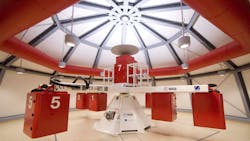Researchers at the European Space Agency (ESA) helped in the development of an alloy that is critical to an emerging series of aerospace applications, a material that reportedly is twice as light as conventional nickel-based super alloys, with comparably good properties for strength and heat-resistance. Creating this alloy is very difficult, however. The production process demands particular capabilities that ESA made available to product engineers, namely the ability to conduct research under all types of gravity.
Aircraft and jet engine designers, as well as airlines, want component and system designs that will reduce aircraft weight, in order to save fuel costs, but without sacrificing engine performance or flight safety. According to ESA, cutting an aircraft’s weight by 1% will save up to 1.5% in fuel volume. For commercial airlines, this savings could reduce operating costs. For passengers, it might result in cheaper fares and more direct routes. A reduced environmental impact would be another benefit, ESA indicated.
Aerospace engineers understand that titanium aluminide (TiAl) alloys offer weight savings over the Ni-based super alloys in standard use for jet engines. TiAl, is a lightweight intermetallic that resists oxidation and heat, but its tensile strength is low. It is particularly difficult to cast, because of the trouble maintaining conditions for thorough mold filling and reliable solidification.
Engineers note that one specific titanium aluminide compound, gamma TiAl, has strong mechanical properties and oxidation- and corrosion-resistance at elevated temperatures: it can withstand extreme temperatures up to 800°C. These factors indicate TiAl-based alloys have a strong potential to increase the thrust-to-weight ratio in an aircraft engine, specifically in low-pressure turbine blades and high-pressure compressor blades. By contrast, Ni-based superalloys reportedly are nearly twice as dense as TiAl-based alloys.
The use of TiAl in aerospace structures is a relatively recent development: jet engine designer/manufacturer GE Aviation chose TiAl for turbine blades in its GEnx engine, which is installed in the Boeing 787 Dreamliner and Boeing 747-8 cargo jets.
There are some investment casting foundries capable of producing TiAl for low-pressure turbines, but the volumes are low due to the production difficulties, and the commercial applications of the material exceeds its availability. Over 1 million turbine blades will be manufactured in the coming decade, according to ESA, and using TiAl would reduce the components’ weight by 45% over current standard materials.
The alloy’s benefits may be significant to automaking as well as aerospace applications, the R&D source stated.
Although it is possible to produce the alloys in laboratory conditions, casting it into turbine blades or other critical shapes required by aircraft engine builders is not simple. ESA scientists worked to address the production problem through the Impress project. The Intermetallic Materials Processing in Relation to Earth and Space Solidification (Impress) project investigates materials processing, structures, and properties of new higher-performance intermetallic alloys for industrial applications, such as turbine blades and catalytic powders. It is a joint effort between the European Commission and ESA.
ESA is an intergovernmental agency that conducts research into issues critical to space exploration. With 20 member states and headquartered in Paris, ESA has a staff of over 2,000 and an annual budget of about $5.38 billion.
Gravity's pull
In industrial-scale research, it’s common for engineers and scientists to eliminate as many variables as possible in order to observe basic interactions. Impress researchers working to develop industrial-scale production techniques for TiAl alloys determined they’d need to eliminate one factor that hampered their observations of the material’s ductility: gravity. That conclusion led to ESA’s involvement.
In space, there is no gravity, so aboard a research rocket launched from Kiruna, Sweden, aluminum samples were heated in a small furnace. During six minutes of free fall, the samples were heated above 700°C and then subjected to X-ray monitoring during the cooling process. From these results, the researchers realized that casting titanium aluminides might require the opposite condition: hypergravity.
“Hypergravity” is the condition in which the force of gravity exceeds that which exists normally on Earth (presented as “1 g” — with g being gravitational acceleration on the Earth’s surface.) To understand and define the influence of gravity, ESA concluded that observing effects of microgravity and 1 g is insufficient: the material’s performance across a broad gravity spectrum to give a complete the picture of its ductility.
So, ESA developed a Large Diameter Centrifuge (LDC), making it possible to collect measurement points in the range from 1 to 20 g. This instrument provides a hypergravity environment for biological, biochemical, microbiological, opto-physical, physical, material and fluid sciences, geology and plasma physics. The LDC is part of the Life and Physical Sciences Instrumentation and Life Support Laboratory (LIS) at ESTEC in The Netherlands, dedicated to European science and technology research programs.
The LDC has a diameter of 8 meters. It has four arms, each of which can support two gondolas with a maximum payload of 80 kg per gondola. In practice, six gondolas are available, plus one gondola in the center for control or reference experiments. The rotation of the LDC then creates the hypergravity field at the experiment site inside each gondola.
Because ESA is the only organization that offers all levels of gravity, the Impress team used the centrifuge at ESTEC to test their theory.
Casting TiAl alloys in a centrifuge creating up to 20 times normal gravity helps the liquid metals to fill every part of a mold, producing a perfectly cast alloy, even with complex shapes.
Analyzing metal casting in multiple was produced the research details that allowed the titanium aluminide industrial process to be refined, and commercialized.
About the Author
Robert Brooks
Content Director
Robert Brooks has been a business-to-business reporter, writer, editor, and columnist for more than 20 years, specializing in the primary metal and basic manufacturing industries. His work has covered a wide range of topics, including process technology, resource development, material selection, product design, workforce development, and industrial market strategies, among others.
